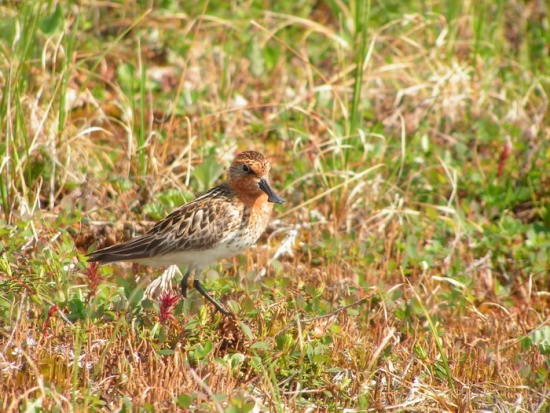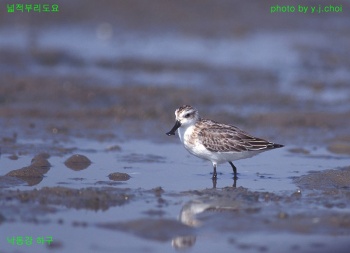(Picture of bird in breeding plumage added) |
Nutcracker (talk | contribs) (more details) |
||
| Line 4: | Line 4: | ||
==Identification== | ==Identification== | ||
[[Image:Spoonbill_Sandpiper.jpg|thumb|350px|right|Photo by {{user|ilovebird|ilovebird}}<br />[[South Korea]]]] | [[Image:Spoonbill_Sandpiper.jpg|thumb|350px|right|Photo by {{user|ilovebird|ilovebird}}<br />[[South Korea]]]] | ||
| − | The average size of the adult Spoon-billed Sandpiper is | + | The average size of the adult Spoon-billed Sandpiper is 14-16 cm long and 29-34 g weight.<br /> |
| − | The Spoon-billed Sandpiper Is a small peep-relative with a unique spatulate-shaped bill. The breeding adult has a rufous head, neck, and chest, with a white underbody and white-outlined black feathers on the upperbody<br /> | + | The Spoon-billed Sandpiper Is a small peep-relative with a unique spatulate-shaped bill, 19-24 mm long and 10-12 mm broad near the tip. The breeding adult has a rufous head, neck, and chest, with a white underbody and white-outlined black feathers on the upperbody; in winter, it is grey above, and white below.<br /> |
| − | The ''' | + | The '''juvenile''' lacks the reddish coloration of the adult, but has white coloration instead with a dark "cheek" and crown. |
====Similar Species==== | ====Similar Species==== | ||
| − | The plumage of this sandpiper is | + | The plumage of this sandpiper is similar to the [[Red-necked Stint]]s, but can be separated from this by the different bill shapes, darker auriculars, and a more sharply defined supercilium on the juvenile Spoon-billed. The strange bill shape can be hard to see from a distance and sometimes other sandpipers with mud stuck on the bill tip can look as though they have the spoon shape. |
==Distribution== | ==Distribution== | ||
| − | The Spoon-billed Sandpiper is | + | The Spoon-billed Sandpiper is an extremely rare bird, listed by the IUCN as Critically Endangered. The global population has collapsed in recent years, with 2,000-2,800 breeding pairs estimated in the mid 1990s but by 2013-2014 falling to under 100 pairs. They breed in northeast [[Russia]]. In migration and winter they are rare, and are found on the east coast of [[Asia]] as far south as the [[Philippines]]. 84 were recently found at two sites in [[Myanmar]]. There have been a few records of the Spoon-billed Sandpiper in [[North America]]; around five in western [[Alaska]] and one breeding adult in [[British Columbia]]. Captive breeding projects are under way in the UK (WWT Slimbridge) and on the breeding grounds in Russia. |
==Taxonomy== | ==Taxonomy== | ||
This is a [[Dictionary_M-O#M|monotypic]] species<sup>[[#References|[1]]]</sup>. | This is a [[Dictionary_M-O#M|monotypic]] species<sup>[[#References|[1]]]</sup>. | ||
==Habitat== | ==Habitat== | ||
| − | The breeding habitat of this bird is on sea coasts with sand and low lying vegetation in the arctic tundra of | + | The breeding habitat of this bird is on sea coasts with sand and low lying vegetation in the arctic tundra of northeast Russia. They also spend time in brackish water. The Spoon-billed Sandpiper winters are intertidal flats and estuaries of the eastern coast of Asia. Habitat loss of the wintering wetlands and illegal hunting are the main reason for this species' low population. Luckily, some of this bird's habitat is being conserved and saved. |
==Behaviour== | ==Behaviour== | ||
====Breeding==== | ====Breeding==== | ||
'''Display''': Each pair of Spoon-billed Sandpiper hold relatively small territories. The males territorial display has trilling calls, sharp dives, circling in loops, and hovering above the ground.<br /> | '''Display''': Each pair of Spoon-billed Sandpiper hold relatively small territories. The males territorial display has trilling calls, sharp dives, circling in loops, and hovering above the ground.<br /> | ||
| − | '''Nesting''': The Spoon-billed Sandpiper nest is built on the ground on the arctic tundra, and usually holds four eggs. They are incubated by both the | + | '''Nesting''': The Spoon-billed Sandpiper nest is built on the ground on the arctic tundra, and usually holds four eggs. They are incubated by both the male and female, though the female leaves when the precocial chicks hatch. The male then takes over caring for the young until they are 17 days old, then leaves them to fend for themselves. |
====Diet==== | ====Diet==== | ||
| − | As post peeps, | + | As post peeps, it forages in shallow water, and mudflats during the winter. The specialised spatulate bill helps the bird grab tiny clams, arthropods, and other invertabrates living in the sand and mud that the bill stirs up as it sweeps from side to side. During the winter the Spoon-billed Sandpiper feeds farther out from shore than the similar Red-necked Stint, which is one way to distinguish the two. |
====Vocalisation==== | ====Vocalisation==== | ||
The call is often described as a high "wheet". They also make staccato, trilling calls in territorial display flights. | The call is often described as a high "wheet". They also make staccato, trilling calls in territorial display flights. | ||
==References== | ==References== | ||
#{{Ref-Clements6thDec09}} | #{{Ref-Clements6thDec09}} | ||
| + | #[http://www.saving-spoon-billed-sandpiper.com/ Saving the Spoon-billed Sandpiper] | ||
| + | #del Hoyo et al., ''Handbook of the Birds of the World''. 1996. | ||
| + | #Hayman et al., ''Shorebirds''. 1986. | ||
{{ref}} | {{ref}} | ||
==External Links== | ==External Links== | ||
Revision as of 15:08, 6 July 2014
- Eurynorhynchus pygmeus
Calidris pygmeus
Identification
The average size of the adult Spoon-billed Sandpiper is 14-16 cm long and 29-34 g weight.
The Spoon-billed Sandpiper Is a small peep-relative with a unique spatulate-shaped bill, 19-24 mm long and 10-12 mm broad near the tip. The breeding adult has a rufous head, neck, and chest, with a white underbody and white-outlined black feathers on the upperbody; in winter, it is grey above, and white below.
The juvenile lacks the reddish coloration of the adult, but has white coloration instead with a dark "cheek" and crown.
Similar Species
The plumage of this sandpiper is similar to the Red-necked Stints, but can be separated from this by the different bill shapes, darker auriculars, and a more sharply defined supercilium on the juvenile Spoon-billed. The strange bill shape can be hard to see from a distance and sometimes other sandpipers with mud stuck on the bill tip can look as though they have the spoon shape.
Distribution
The Spoon-billed Sandpiper is an extremely rare bird, listed by the IUCN as Critically Endangered. The global population has collapsed in recent years, with 2,000-2,800 breeding pairs estimated in the mid 1990s but by 2013-2014 falling to under 100 pairs. They breed in northeast Russia. In migration and winter they are rare, and are found on the east coast of Asia as far south as the Philippines. 84 were recently found at two sites in Myanmar. There have been a few records of the Spoon-billed Sandpiper in North America; around five in western Alaska and one breeding adult in British Columbia. Captive breeding projects are under way in the UK (WWT Slimbridge) and on the breeding grounds in Russia.
Taxonomy
This is a monotypic species[1].
Habitat
The breeding habitat of this bird is on sea coasts with sand and low lying vegetation in the arctic tundra of northeast Russia. They also spend time in brackish water. The Spoon-billed Sandpiper winters are intertidal flats and estuaries of the eastern coast of Asia. Habitat loss of the wintering wetlands and illegal hunting are the main reason for this species' low population. Luckily, some of this bird's habitat is being conserved and saved.
Behaviour
Breeding
Display: Each pair of Spoon-billed Sandpiper hold relatively small territories. The males territorial display has trilling calls, sharp dives, circling in loops, and hovering above the ground.
Nesting: The Spoon-billed Sandpiper nest is built on the ground on the arctic tundra, and usually holds four eggs. They are incubated by both the male and female, though the female leaves when the precocial chicks hatch. The male then takes over caring for the young until they are 17 days old, then leaves them to fend for themselves.
Diet
As post peeps, it forages in shallow water, and mudflats during the winter. The specialised spatulate bill helps the bird grab tiny clams, arthropods, and other invertabrates living in the sand and mud that the bill stirs up as it sweeps from side to side. During the winter the Spoon-billed Sandpiper feeds farther out from shore than the similar Red-necked Stint, which is one way to distinguish the two.
Vocalisation
The call is often described as a high "wheet". They also make staccato, trilling calls in territorial display flights.
References
- Clements, JF. 2009. The Clements Checklist of Birds of the World. 6th ed., with updates to December 2009. Ithaca: Cornell Univ. Press. ISBN 978-0801445019.
- Saving the Spoon-billed Sandpiper
- del Hoyo et al., Handbook of the Birds of the World. 1996.
- Hayman et al., Shorebirds. 1986.
Recommended Citation
- BirdForum Opus contributors. (2024) Spoon-billed Sandpiper. In: BirdForum, the forum for wild birds and birding. Retrieved 29 April 2024 from https://www.birdforum.net/opus/Spoon-billed_Sandpiper
External Links





